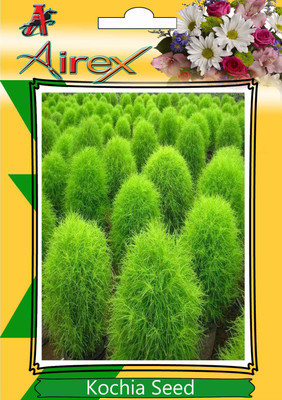Airex Kochia Seed(20 per packet)
Quick Overview
Product Price Comparison
Growing Kochia Flower:Kochia is an introduced, erect, annual forb with a taproot that formspyramidal or rounded bushes up to 7 feet (2.1 m) tall.Phillips and Launch baugh (1958) reported that the rootsof Kochia scoparia can reach a depth of at least 8 feet(2.4 m) and have a horizontal radius of at least 8 feet (2.4m) which would allow the plant to draw water from acylindrical soil mass 16 feet (4.9 m) in diameter and 8 feet(2.4 m) or more deep.The leaves have alternate arrangement and are simple,linear to narrowly ovate to 5.5 cm long and can have hairs, depending on age. Leaves are very short petioled orsessile. The leaves have 1-5 prominent veins with entiremargins fringed with hairs. Stem is green, red tinged, orred depending on age (Friesen et al., 2009). The flowersare green leaf-like bracts and surrounded by tufts of hai(Stubbendieck et al., 2003). The inflorescence is a spikeand is axillary and terminal.Kochia has utricle fruitswith an oval, brown to black seed (Stubbendieck et al.2003). Kochia varies widely in morphological characters partially due the environment where it is found.Although Kochia is widely grown as a forage crop, its beauty is appealing to the average gardener. It has been grown as an ornamental since the early 1900s. Home gardeners can successfully plant kochia seeds directly into the flower bed or in a pot. Sow the seeds in the spring, after all danger of frost has passed. Pick a sunny location in the garden and cover the seeds with 1/4 of an inch of soil. Keep the seeds moist until germination occurs. Once the seeds start to grow, water the seedlings once per week. Kochia thrives on drought like conditions. Kochia is a common plant to place beside evergreens because it produces brilliant pink foliage that stands out in stark contrast to the evergreen's green and makes kochia a garden focal point. Keep kochia trimmed back to prevent the plant from producing seeds which can spread rapidly in the garden and become a nuisance.


